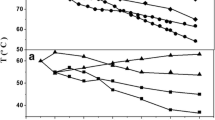Abstract
The preparation of microlatex dispersions from microemulsions of a monomer (styrene, methylmethacrylate or vinyl acetate) is described. A simple method for preparing the microemulsion has been devised. This consists of forming a water-in-oil (w/o) emulsion using a low (HLB) surfactant (nonylphenol with 5, 6 or 7 moles ethylene oxide) and then titrating with an aqueous solution of a high HLB surfactant (nonylphenol with 15 or 16 moles ethylene oxide). A small amount of anionic surfactant (sodium lauryl sulphate, sodium dodecyl benzene sulphonate or dioctyl sulphosuccinate) was also incorporated to enhance the stability of the w/o emulsion and facilitate the inversion to an o/w microemulsion. The droplet-size distribution of the resulting microemulsion was determined using photon-correlation spectroscopy.
Three different methods of polymerising the microemulsion were used. These were thermally induced polymerisation using potassium persulphate, azobis-2-methyl propamidinium dichloride (AMP-water-soluble initiators) or azobisisobutyronitrile (AIBN, an oil-soluble initiator). All these initiators required heating to 60°C, i.e. above the stability temperature of the microemulsion. In this case, the microlatices produced were fairly large (37–100 nm diameter) and had a broad particle-size distribution. The second polymerisation procedure was chemically induced using a redox system of hydrogen peroxide and ascorbic acid. This produced microlatices with small sizes (18–24 nm diameter) having a narrow-size distribution. The microlatex size was roughly two to three times the size of the microemulsion droplets. This showed that collision between two or three microemulsion droplets resulted in their coalescence during the polymerisation process. The third method of polymerisation was based on UV irradiation in conjunction with K2S2O8, AMP or AIBN initiators. In this case, the microlatex size was also small (30–63 nm) with a narrow particle-size distribution.
Microlatex particles were also prepared using a mixture of monomers (styrene plus methylmethacrylate) or mixture of monomers and a macromonomer, namely methoxy (polyethylene glycol)methacrylate. The latter was used to produce “hairy” particles, i.e. with grafted polyethylene oxide (PEO) chains.
The stability of the microlatices was determined by adding electrolytes (NaCl, CaCl2, Na2SO4 or MgSO4) to determine the critical flocculation concentration (CFC). The nonionic latices were very stable giving no flocculation up to 6 mol dm−3 NaCl or CaCl2 and a CFC of 0.6 mol dm−3 for Na2SO4 or MgSO4. Charged latices were less stable than the nonionic ones. The critical flocculation temperatures (CFT) of all latices were determined as a function of electrolyte concentration. With the nonionic latices, CFC was higher than the θ-temperature for polyethylene oxide at the given electrolyte concentration. This indicated enhanced steric stabilisation as a result of the dense packing of the chains and hence an elastic contribution to the steric interaction. This was not the case with the charged latex, which showed CFT values lower than the θ-temperature. The “hairy” latices [i.e. those containing methoxy polyethylene glycol (PEG) methacrylate] were also less stable towards electrolyte (CFT was much lower than θ-temperature), indicating a low density of PEO layers.
Similar content being viewed by others
References
Kitano H, Iwai S, Okubo T, Ise N (1987) J Am Chem Soc 109:7608
Shirahama H, Suzawa T (1985) J Colloid Interface Sci 104:416, ibid (1986) 109:552
Suzawa T, Murakami T (1980) J Colloid Interface Sci 78:266
Suzawa T, Shirahama H, Fujimoto T (1982) J Colloid Interface Sci 86:144
Suzawa T, Shirahama H, Fujimoto T (1983) J Colloid Interface 93:498
Rembaum A, Yen SP, Cheong E, Wallace S, Molday RS, Gordon IL, Drever WJ (1976) Macromolecules 9:328
Crane LJ (1981) Clin Chem 27:697
Bernard AM, Moreau D, Lauwerys RR (1982) Clin Chem 28:1167
Goodwin JW, Hearn J, Ho CC, Ottewill RH (1974) Colloid Polym Sci 252:464
Bromley C (1985) Colloids and Surfaces 17:1
Atik SS, Thomas JK (1981) J Am Chem Soc 103:4279
Candau F, Leong YS, Pouyet G, Candau S (1984) J Colloid Interface Sci 101:167
Candau F, Zekhnini Z, Durand JP (1986) J Colloid Interface Sci 114:298
Schulman JH, Cockbain EG (1940) Trans Faraday Soc 36:551
Schulman JH, Matalon R, Cohen M (1951) Faraday Soc Disc 11:117
Schulman JH, Stoeckenius W, Prince LM (1959) J Phys Chem 63:1677
Stoffer JO, Bone T (1980) J Polym Sci, Polym Chem Ed 2641
Pusey PN (1973) In: Green JHS, Dietz R (eds) Industrial polymers characterisation of molecular weight. Transcription Books, London, pp 26–76
Tadros ThF, Vincent B (1980) J Phys Chem 84:1575
Napper DH (1983) Polymeric stabilisation of colloidal dispersions. Academic Press, London, NY
Author information
Authors and Affiliations
Rights and permissions
About this article
Cite this article
Larpent, C., Tadros, T.F. Preparation of microlatex dispersions using oil-in-water microemulsions. Colloid Polym Sci 269, 1171–1183 (1991). https://doi.org/10.1007/BF00654125
Received:
Accepted:
Issue Date:
DOI: https://doi.org/10.1007/BF00654125




